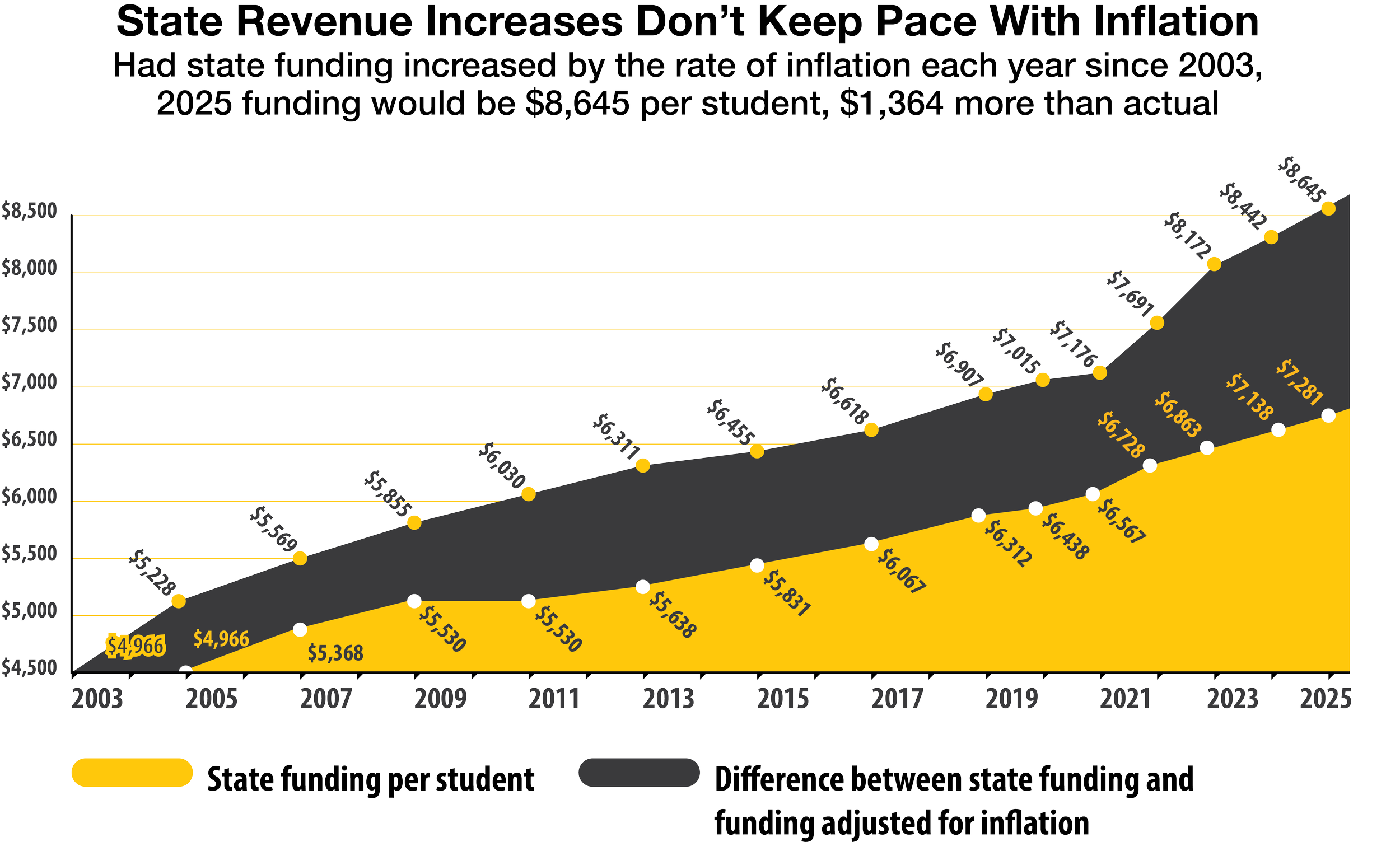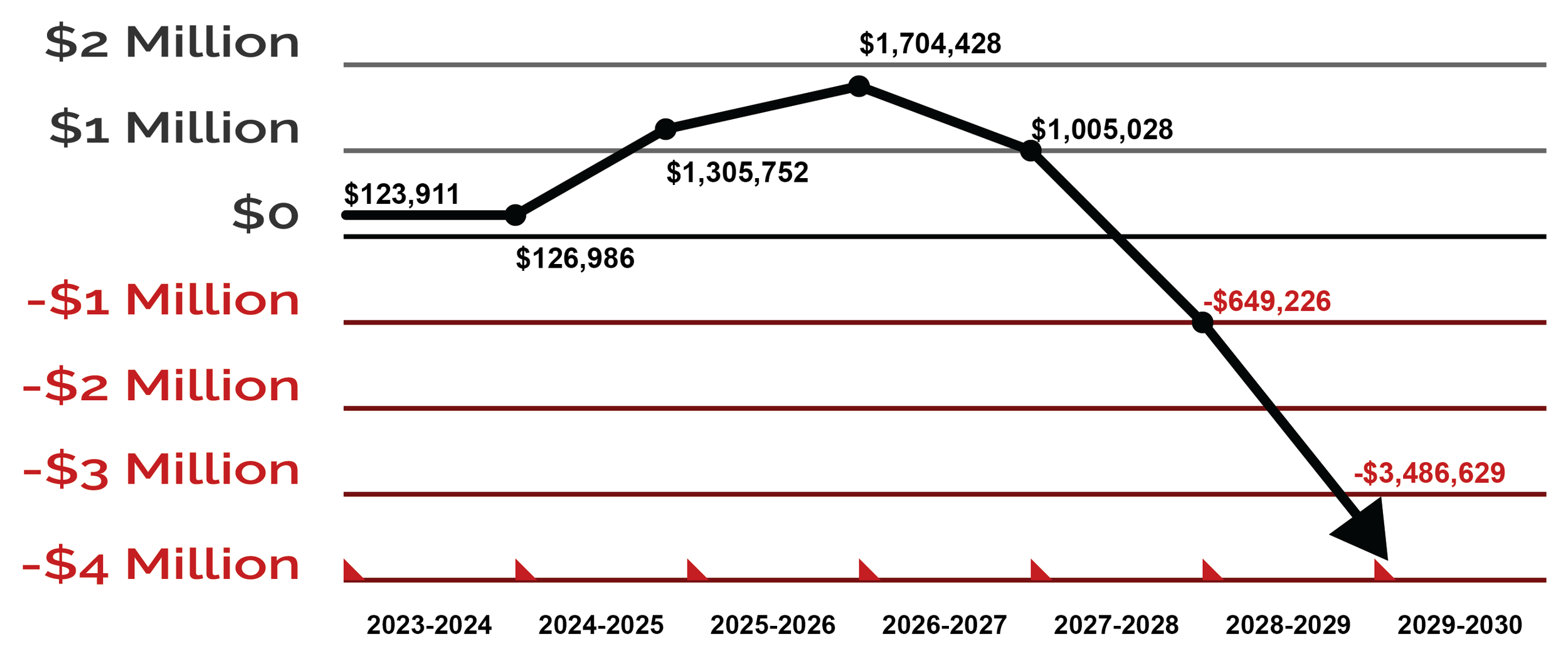THE NEED
Our schools have begun to face serious challenges that affect teaching and learning.
The Funding Challenge
Byron Public Schools has done well to maintain stable finances for many years largely because enrollment, and the funding that comes with new students, was growing. Growth has slowed in recent years and many factors have combined to eat away at our fund balance, or savings account. A structural deficit led to more than $3 million in combined budget reductions last year and this year. More cuts are on the horizon without additional revenue.
Rising Costs, Static Revenue
Our district has experienced several financial pressures:
State revenue increases haven't kept pace with inflation – had state funding increased by the rate of inflation each year since 2003, 2025 funding would be $8,543 per student, $1,262 more than actual – with 2,324 students, that’s the equivalent of nearly $3 million annually
Byron Public Schools received the third lowest state funding among Minnesota's 331 school districts for the 2023-2024 school year. Our district faces a significant disadvantage compared to neighboring communities while dealing with the same rising costs as schools statewide.
Already Taking Action
New state mandates like paid Family Medical Leave and unemployment benefits came with little or no funding
Enrollment (and associated revenue) growth has slowed
Some costs are increasing at a rate greater than average inflation
Additional expenses from new state mandates, such as paid Family Medical Leave, unemployment, etc.
Rising Costs, Static Revenue
In 2023, the State of Minnesota approved a significant increase in revenue for schools, for which we are thankful. Unfortunately, the state also increased the number of unfunded or underfunded mandates. By some estimates, there were more than 60 new mandates for school districts. Some costly examples:
Unemployment pay for hourly staff during summers
Paid Family Medical Leave
Employer increase in Teachers Retirement Association contribution
New curriculum requirements with no funding for curriculum materials and teacher training
Our enrollment numbers have leveled off since 2020 and have even experienced a slight decrease in recent years. This is due to several factors, including lower birth rate, a move during the pandemic by families to homeschool children, and competition from private schools.
Other budget impacts include:
Increased costs of employee salaries and benefits
Increased costs related to purchased services including transportation
Increased costs related to inflation
Byron has already made difficult decisions to balance the budget:
$3+ million in budget cuts over the past two years - see cuts from 2024-2025 and 2025-2026
Operating with minimal reserves after spending down the fund balance (the district's savings account)
The upcoming referendum represents the district's effort to address these structural funding challenges while maintaining educational quality for Byron students.
Budget Cuts Impact the Classroom
Did you know that 77% of Byron’s budget comes from salaries and benefits? When budget reductions are made, most cuts come at the expense of school staff.
Budget reductions of $1.6 million last year spared active staff as much as possible. The largest savings were made by not replacing staff that retired or resigned, including teachers, instructional coaches, a counselor, a nurse, the building and grounds director, and five para-professionals.
Budget reductions for this year also totaled $1.6 million, but with fewer retirees, budget reductions are impacting the classroom directly. Cuts included:
12 Teaching Staff - 7 at elementary, 1 at the middle school, and 4 at the high school.
2 Counselors
Licensed School Nurse
Reduce Tech Specialist to .5 FTE, and more
Due to the cuts, class sizes now range from 19-33 students, and exceed school board goals at grades 1, 3, 4, 5 and 6. Over the last two years, staff has been reduced as follows:
Teaching Staff - 15%
Support Staff - 15%
Administration - 31%
In addition, nearly a half million dollars in cuts to activities, technology, and district-wide services were made, and student fees were increased.
Bank Account Drained by 2027
If nothing is done, our budget forecast anticipates the district to be in “Statutory Operating Debt” (SOD), or -2.5% of the annual expense budget, in a few short years. Once in SOD, a school district loses some autonomy to the state of Minnesota.
Technology Needs Are Increasing
Public schools are in constant need of updating technology, including preventing cybersecurity threats to shield student data, providing reliable networks to keep classrooms connected, modern classroom display systems for engaging instruction, and improving safety systems that control and monitor building access.
At Byron Public Schools we have a need for:
Cybersecurity: Data breaches, ransomware, and other cyber threats are growing. We have some systems in place, but an investment is needed to be more prepared to defend against these attacks.
Infrastructure: Networks, servers, Wi-Fi, and access points are the infrastructure backbone that keeps our staff and students teaching and learning. This equipment is replaced on a regular schedule to ensure a safe and stable learning environment.
Classroom Technology: Classroom display systems and other instructional tools must be updated over time to ensure teachers have the tools they need to deliver engaging and effective instruction.
Physical Security: Access controls and monitoring systems safeguard our buildings, protect sensitive areas, and help ensure the safety of students and staff.
At this time, technology needs are funded by our school district’s general fund – the same fund that pays teacher salaries. Many school districts are turning to a dedicated funding source from local property taxpayers to ensure stability in technology systems.




